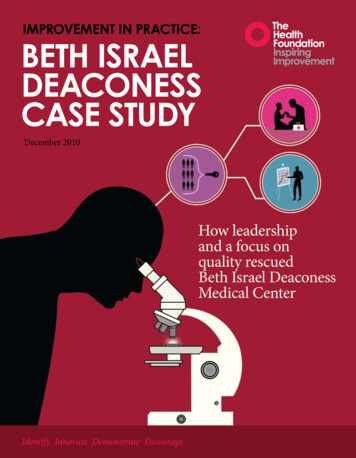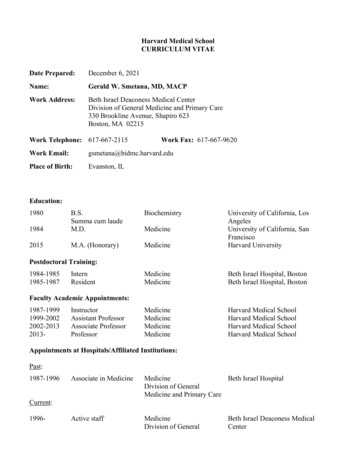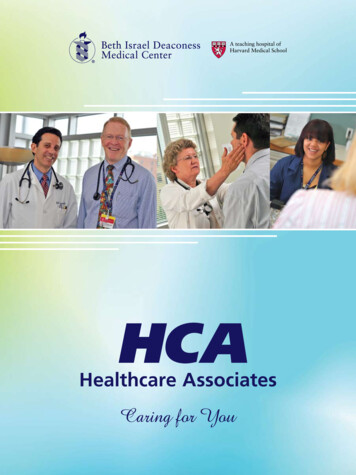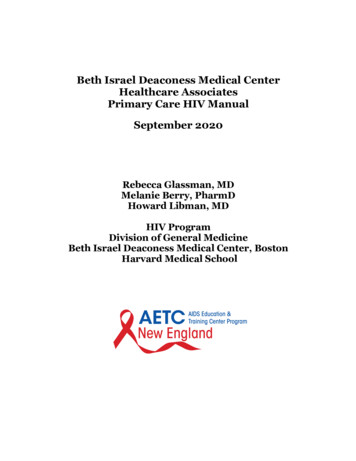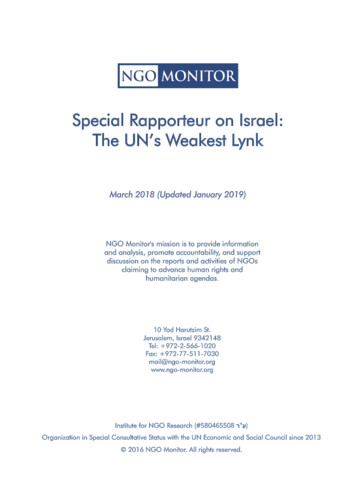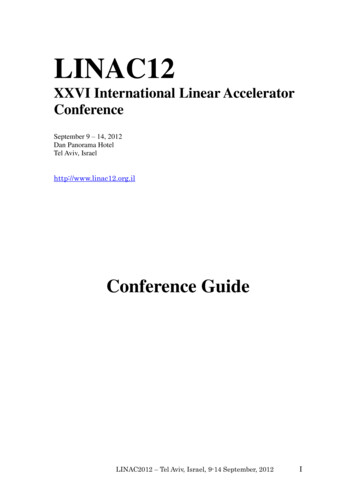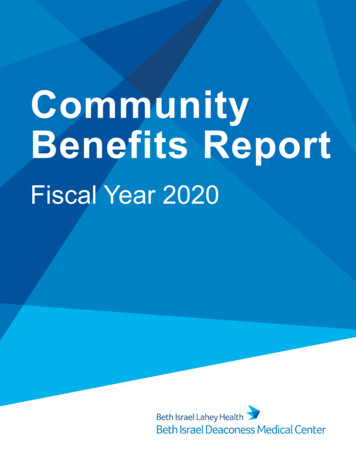
Transcription
CommunityBenefits ReportFiscal Year 2020
TABLE OF CONTENTSSECTION I: SUMMARY AND MISSION STATEMENT . 2Target Populations3Basis for Selection4Key Accomplishments for Reporting Year4Plans for Next Reporting Year5SECTION II: COMMUNITY BENEFITS PROCESS . 7Community Benefits Leadership/Team and Community Benefits Advisory Committee7Community Benefits Advisory Committee Meetings9Community Partners9SECTION III: COMMUNITY HEALTH NEEDS ASSESSMENT . 11Approach and Methods11Summary of FY19 CHNA Key Health-Related Findings12SECTION IV: COMMUNITY BENEFITS PROGRAMS . 15SECTION V: EXPENDITURES . 93SECTION VI: CONTACT INFORMATION . 95SECTION VII: HOSPITAL SELF-ASSESSMENT FORM . 961
SECTION I: SUMMARY AND MISSION STATEMENTSummary and Mission StatementBeth Israel Deaconess Medical Center (BIDMC) is a member of Beth Israel Lahey Health(BILH). BILH brings together an exceptional array of clinical organizations spanning the fullcontinuum of health care delivery–academic and teaching hospitals, community hospitals,ambulatory and urgent care centers, behavioral health programs, and home care–in a sharedmission to expand access to great care and advance the science and practice of medicinethrough groundbreaking research and education.At the heart of BILH is the belief that everyone deserves high-quality, affordable health care.This belief is what drives BILH to work with community partners across the region topromote health, expand access, and deliver the best care in the communities BILH serves.BILH Community Benefits staff are committed to working collaboratively with BILH’scommunities to address leading health issues and create a healthy future for individuals,families, and communities.The mission of BIDMC is to serve BIDMC patients compassionately and effectively, and tocreate a healthy future for them and their families. BIDMC’s mission is supported byBIDMC’s commitment to personalized, excellent care for patients; a workforce committed toindividual accountability, mutual respect, and collaboration; and a commitment tomaintaining financial health. BIDMC is also committed to being active in the community.Service to community is at the core of BIDMC’s mission. The BIDMC founders made acovenant to care for the underserved in the hospital’s service area, attend to unmet need, andaddress disparities in access to care and health outcomes. BIDMC’s commitment to thiscovenant and the people it serves remains steadfast today.The following annual report provides specific details on how BIDMC is honoring itscommitment and includes information on BIDMC’s Community Benefits Service Area(CBSA), community health priorities, target populations, community partners, and detaileddescriptions of its Community Benefits programs and their impact.More broadly, the BIDMC Community Benefits mission is fulfilled by: 2Involving BIDMC’s staff, including its leadership and dozens of communitypartners in the community health assessment process as well as in the development,implementation, and oversight of the hospital’s three-year Implementation Strategy(IS);
Engaging and learning from residents throughout BIDMC’s service area in allaspects of the Community Benefits process, including assessment, planning,implementation, and evaluation. The hospital pays special attention to engaging thosecommunity members who are not patients of BIDMC and those who are often left outof assessment, planning, and program implementation processes Assessing unmet community need by collecting primary and secondary data (bothquantitative and qualitative) to identify unmet health-related needs and to characterizethose in the community who are most vulnerable and face disparities in access andoutcomes; Implementing community health programs and services in BIDMC’s CBSA thatis geared toward improving the current and future health status of individuals,families, and communities by removing barriers to care, addressing socialdeterminants of health, strengthening the healthcare system, and working to decreasethe burden of leading health issues; Promoting health equity by addressing social and institutional inequities, racism,and bigotry and ensuring that all patients are welcomed and received with respect andhave access to culturally responsiveness care; and Facilitating collaboration and partnership within and across sectors (e.g., publichealth, health care, social services, business, academic, and community health) toadvocate for, support, and implement effective health policies, community programs,and services.Target PopulationsBIDMC’s CBSA includes the Boston neighborhoods of Allston/Brighton, Bowdoin/Geneva,Chinatown, Fenway/Kenmore, Mission Hill, and Roxbury, the City of Chelsea, and thetowns of Brookline, Lexington, Needham, and Newton (Chestnut Hill). BIDMC’s FY19Community Health Needs Assessment’s (CHNA) findings, on which this report is based,clearly show that low-income and racially/ethnically diverse populations living in Boston’sneighborhoods of Allston/Brighton, Bowdoin/Geneva, Chinatown, Fenway/Kenmore,Mission Hill, and Roxbury, as well as the adjacent City of Chelsea, face the greatest healthdisparities and are most at-risk. As a result, these Boston neighborhoods and the City ofChelsea have been identified and prioritized as the focus for community health efforts.The FY19 CHNA also identified three smaller but high need segments of the population thatare also underserved, at-risk, and face disparities, namely youth, older adults, and the LesbianGay Bisexual Transgender and Queer (LGBTQ) community. Collectively, these geographic,demographic, and socio-economic population segments are BIDMC priority populations.While BIDMC is committed to improving the health status and well-being of those livingthroughout its entire service area, per the Commonwealth’s updated Community Benefits3
guidelines, BIDMC’s IS will focus on the following most at-risk priority populations in thesix Boston neighborhoods and the City of Chelsea–Low-Income, Racially/EthnicallyDiverse, LGBTQ, Older Adults, Youth, and Limited English Proficient.Basis for SelectionCommunity health needs assessments; public health data available from government(MDPH, Boston Public Health Commission, federal agencies) and private resources(foundations, advocacy groups); BIDMC’s areas of expertise.Key Accomplishments for Reporting YearThe accomplishments highlighted in this report are based upon priorities identified andprograms contained in BIDMC’s FY19 Community Health Needs Assessment (CHNA) andFY20-22 Implementation Strategy (IS): Continued to support increased capacity of primary care and OB/GYN practices at sixaffiliated health centersContinued community-based specialty care servicesProvided culturally sensitive care for patients through cancer navigation, interpreterservices, and multilingual patient educationAddressed social determinants of health, in particular violence prevention, throughthe Center for Violence Prevention and Recovery (CVPR) and Bowdoin Street HealthCenter’s (BSHC) Neighborhood Trauma TeamIncreased capacity of primary care clinicians at CHCs to provide needed behavioralhealth services through integration of behavioral health with primary careContinued workforce development through summer internships for underservedyouth, pipeline programs, and training programs for adultsPromoted healthy lifestyles through the Walking Club, Farmers Markets, and Fitnessin the City; pivoted programming to address food insecurity in light of COVID-19Conducted research that supports the understanding of health disparitiesProvided access to wellness programming including exercise classes and virtualofferings at the Wellness Center at BSHCSupported youth in developing leadership skills to prevent violence and create changein their community through the Youth Leadership Program at BSHCDuring FY20, BIDMC dedicated significant time and resources to respond to COVID-19needs. BIDMC worked with its licensed and affiliated community health centers and thehospitals Chelsea location to expand community testing access. Both BSHC, the hospital’slicensed health center, and its Chelsea location reduced barriers to access by offering on-siteinterpretation, welcoming walk-ins, and not requiring a physician order. The hospital alsoworked with BILH to develop and distribute written materials (in nine languages) to thecommunities most impacted by COVID-19 to help slow the spread of the virus and delineatewhere residents could access services and resources in their community. BILH and BIDMCredeployed staff, supplies, and other materials to both the community and within hospitals,including Personal Protective Equipment (PPE), food, hand sanitizer, etc.4
COVID-19 caused several programs highlighted in this report to be modified. In some cases,programs were expanded, and in others, programs were reduced in response to the pandemicand its impact on our community.Plans for Next Reporting YearIn FY19, BIDMC conducted a comprehensive and inclusive CHNA that included qualitativeand quantitative data collection, robust community engagement activities, and an inclusiveprioritization process. These activities were in full compliance with the Commonwealth’supdated Community Benefits Guidelines for FY19. In response to the FY19 CHNA, BIDMCwill focus its FY20-22 IS on four priority areas; these priority areas collectively address thebroad range of health and social issues facing residents living in BIDMC’s CBSA who facethe greatest health disparities. These four priority areas are: Social Determinants of Health;Chronic/Complex Conditions and Risk Factors;Access to Care; andBehavioral Health (Mental Health and Substance Use)These priority areas are aligned with the statewide health priorities identified by theExecutive Office of Health and Human Services (EOHHS) in 2017 (i.e., Chronic Disease,Housing Stability/Homelessness, Mental Illness and Mental Health, and Substance UseDisorders). BIDMC’s priorities are also aligned with the priorities identified by theMassachusetts Department of Public Health (DPH) to guide the Community-based HealthInitiative (CHI) investments funded by the Determination of Need (DON) process, whichunderscore the importance of investing in the Social Determinants of Health (i.e., builtenvironment, social environment, housing, violence, education, and employment).The FY19 CHNA provided new guidance and invaluable insights on quantitative trends andcommunity perceptions that are being used to inform and refine BIDMC’s efforts. Incompleting the FY19 CHNA and FY20-22 IS, BIDMC, along with its other health, publichealth, social service, and community partners, is committed to improving the health statusand well-being of all residents living throughout its CBSA. As discussed above, based on theCHNA’s quantitative and qualitative findings, including discussions with a broad range ofcommunity participants, there was agreement that BIDMC’s FY20-22 IS should prioritizecertain demographic, socio-economic, and geographic population segments that havecomplex needs and face barriers to care, service gaps, and other adverse social determinantsof health. These factors put these segments at greater risk, limit their access to neededservices, and can often lead to disparities in health outcomes. More specifically, the FY19CHNA identified the importance of supporting initiatives that target low-income populations,youth, older adults, racially/ethnically diverse populations, limited English proficiencypopulations, and LGBTQ populations.BIDMC partners with dozens of community-based organizations and service providers toexecute its IS, including public agencies, social service providers, community healthorganizations, academic organizations, and businesses. BIDMC also partners with numerous5
CHCs through the Community Care Alliance (CCA, BIDMC’s health center network) toimplement programs that address health disparities (related to race, ethnicity, sexualorientation, gender identity, and physical attributes) and implement focused public healthprograms and chronic disease management programs, including efforts to address health riskfactors such as healthy eating and active living. BIDMC also partners with these healthcenters to implement, strengthen, and leverage the patient-centered medical home servicedelivery model to promote coordinated, cost-effective, high quality care for the community.Example programs/strategies in the FY20-22 IS include: Supporting and collaborating with community-based organizations to promote accessto affordable, healthy food Supporting the Fitness in the City Program at BSHC Holding healing services (circles) when appropriate for community residents affectedby violence Responding to all incidents of homicide or violence within a catchment area that meetcriteria established by the Boston Public Health Commission Implementing and expanding education and workforce development opportunitiessuch as English as a Second Language, High School Equivalency, computer skills,citizenship, and financial literacy classes Linking patients screened positive for cancer to Cancer Patient Navigators Providing free or subsidized medications to eligible, low income patients Increasing access to care and services for Limited English Proficient individuals Supporting primary care and behavioral health integration at BIDMC’s CCA clinicsites and BIDMC’s Chelsea service site, as well as at BIDMC’s Affiliated PhysiciansGroup (APG) and Healthcare Associates (HCA) practices Supporting programs in CCA clinics that educate and screen patients for diabetes,hypertension, and persistent asthma Providing services for domestic violence, sexual assault, and community violencevictims through BIDMC’s CVPR programHospital Self-Assessment FormWorking with its Community Benefits leadership team and its Community Benefits AdvisoryCommittee (CBAC), the BIDMC Community Benefits team completed a hospital selfassessment form (Section VII, page 94). The BIDMC Community Benefits team also sharedthe Community Representative Feedback Form with all CBAC members.6
SECTION II: COMMUNITY BENEFITS PROCESSCommunity Benefits Leadership/Team and Community Benefits Advisory Committee(CBAC):The Community Benefits Advisory Committee (CBAC) works in collaboration withBIDMC’s hospital leadership, including the hospital’s governing board and seniormanagement, to support BIDMC’s Community Benefits mission to serve its patientscompassionately and effectively, and to create a healthy future for them, their families, andBIDMC’s community. The CBAC provides input into the development and implementationof BIDMC’s Community Benefits programs in furtherance of BIDMC’s Community Benefitsmission.The membership of BIDMC’s CBAC is representative of the constituencies and prioritypopulations served by BIDMC’s programmatic endeavors, including those from diverseracial and ethnic backgrounds, age, gender, sexual orientation and gender identity, as well asthose from corporate and non-profit community organizations. Senior management isactively engaged in the development and implementation of the Community Benefits plan,ensuring that hospital policies and resources are allocated to support planned activities.It is not only the Board members and senior leadership who are held accountable forfulfilling BIDMC’s Community Benefits mission. Among BIDMC’s core values is therecognition that the most successful Community Benefits programs are implementedorganization wide and integrated into the very fabric of the hospital’s culture, policies, andprocedures. A commitment to Community Benefits is a focus and value manifestedthroughout BIDMC’s structure and reflected in the myriad programs provided throughdifferent departments at the hospital and how it provides care at the hospital and in affiliatedpractices.BIDMC is a member of BILH. While BIDMC oversees local Community Benefitsprogramming and community engagement efforts, Community Benefits is under the purviewof the BILH Chief Strategy Officer. This structure ensures that Community Benefits efforts,prioritization, planning, and strategy align and are integrated with local and system strategicand regulatory priorities.Providing direction for BIDMC’s collective commitment and effort are The CommunityBenefits Guiding Principles that follow below. Adopted by a broad-based constituency ofBoard, senior leadership and staff, these principles provide the framework for the executionof the plan, spearheaded by the Director of Community Benefits. The Director is accountableto the BILH Vice President of Community Benefits and Community Relations and the ChiefStrategy Officer for BILH. The Vice President of Community Benefits and CommunityRelations also has direct access to the BIDMC President. It is the responsibility of these foursenior managers to ensure that Community Benefits is addressed by the entire organization7
and the needs of the underserved populations are considered every day in discussions onresource allocation, policies, and program development.This is the structure and methodology employed to ensure that Community Benefits is not thepurview of one office alone and to maximize the extent to which efforts across theorganization are fulfilling the mission and goals of Community Benefits.Guiding Principles of BIDMC’s Community Benefits ProgramI.Why?Our Community Benefits program is designed to ensure that: II.What and for Whom? III.Community Benefits calls for a particular focus on underserved populations.Individuals may be underserved due to the many factors that influence if and how oneis able to access and interact effectively with the healthcare system, including incomelevel, insurance status, health status, ethnicity, sexual orientation, gender identity,age, etc.A major focus is to ensure that Beth Israel Deaconess Medical Center is a welcomingand culturally competent organization for all patients and employees, includingracially/ethnically diverse populations and other populations traditionallyunderserved.Our efforts focus primarily, but not exclusively on healthcare, so that our financialresources are leveraged with our clinical, academic, and administrative strengths.The healthcare arena is where Beth Israel Deaconess Medical Center can have thegreatest impact on the community.How? 8Beth Israel Deaconess Medical Center is a good corporate citizen and, as a not-forprofit organization, fulfills its special obligation to serve the community.As a healthcare provider, our services improve the health status of the community.We remain true to the histories of Beth Israel and New England Deaconess Hospitals,each of which was particularly committed to the community service component oftheir multiple missions (clinical, research, teaching, community).The experiences of staff and providers at Beth Israel Deaconess Medical Center areenriched through opportunities to work with diverse patients, colleagues, andorganizations.We partner with community leaders and community-based organizations; they serveas links to the community and teachers of how we can better serve the populationsthey represent. In addition, we collaborate with a wide variety of organizations
because healthcare services by themselves are not adequate to maximizeimprovement of health status.Improving the community’s health requires more than clinical services. We look topublic health, prevention, and other health-related approaches not traditionallyprovided by many acute care hospitals.Our commitment to the Community Benefits mission is as fundamental as ourcommitment to our patient care and academic missions. We will constantly seek waysto fulfill all of them in as effective and efficient a manner as possible.Community Benefits programs are most successful when implemented organizationwide, just as are quality and respect. Community Benefits cannot succeed as a standalone activity. The importance of these principles and the efforts that result must beembraced by trustees, senior management and providers alike, as well as by thecommunities served.Community Benefits Advisory Committee MeetingsOctober 22, 2019January 28, 2020April 28, 2020June 23, 2020September 22, 2020Community PartnersBIDMC recognizes its role as a tertiary/academic resource in a larger health system andknows that to be successful it needs to collaborate with its community partners and those itserves. BIDMC’s Community Health Needs Assessment (CHNA) and the associatedImplementation Strategy (IS) were completed in close collaboration with BIDMC’s staff, itshealth and social service partners, and the community at-large. BIDMC’s CommunityBenefits program exemplifies the spirit of collaboration that is such a vital part of BIDMC’smission.BIDMC serves and collaborates with all segments of the population. However, in recognitionof its long-standing ties to specific Boston neighborhoods and the health disparities that existfor these communities, BIDMC focuses its Community Benefits efforts on improving thehealth status of the low-income, underserved populations living in Allston/Brighton,Chinatown, Bowdoin/Geneva, Fenway/Kenmore, Mission Hill, Roxbury, and the City ofChelsea.BIDMC currently supports dozens of educational, outreach, community health improvement,and health system strengthening initiatives within the Commonwealth. In this work, BIDMCcollaborates with many of Boston’s leading healthcare, public health, and social serviceorganizations. BIDMC has particularly strong relationships with many of the communityhealth centers that operate in its CBSA. These health centers, that are part of the CommunityCare Alliance (CCA), are critical components of the health care safety net in thecommunities in which they operate. In 2020, the CCA health centers provided primary care9
medical, dental, behavioral health, and enabling services to approximately126,733 patients.The CCA health centers include: Bowdoin Street Health Center Charles River Community Health The Dimock Center Fenway Health and Sidney Borum Jr. Health Services South Cove Community Health CenterWhile Outer Cape Health Services (OCHS) voluntarily requested to leave the CCA, BIDMCcontinues its affiliation with and support of OCHS. These health centers are idealCommunity Benefits partners because they are rooted in their communities and, as federallyqualified health centers1, are mandated to serve low-income, underserved populations.These community partners have been a vital part of BIDMC’s community healthimprovement strategy since 1968. Historically, BIDMC has relied heavily on its CCApartners, as well as a number of other key community health partners, to implement itsCommunity Benefits initiatives. In this regard, BIDMC has leveraged CCA’s expertise andthe vital connections that these organizations have with the residents and other communitybased organizations that operate in the communities they serve.BIDMC is also an active participant in the North Suffolk Integrated Community HealthNeeds Assessment (iCHNA) and a founding member of the Boston CHNA- CommunityHealth Improvement Plan (CHIP) Collaborative. Joining with such grass-roots communitygroups and residents, the BPHC, MDPH, and other academic medical centers, BIDMCstrives to create a vision for both city-wide and neighborhood-based health improvement.Another important partnership is BIDMC’s involvement with the Initiative to EliminateCancer Disparities (IECD) through the Dana-Farber/Harvard Cancer Center (DF/HCC), ofwhich BIDMC is a founding member. Collectively the IECD, the DF/HCC, BIDMC andothers are working to address the unequal burden of cancer within diverse communities byfacilitating research in disparities and minority clinical trial education and enrollment.BIDMC’s Board of Directors along with its clinical and administrative staff is committed toimproving the health and well-being of residents throughout its service area and beyond.World-class clinical expertise, education and research along with an underlying commitmentto health equity are the primary tenets of its mission. BIDMC’s Community BenefitsDepartment, under the direct oversight of BIDMC’s Board of Directors, is dedicated tocollaborating with community partners and residents and will continue to do so in order tomeet its Community Benefits obligations.See Appendix A for a comprehensive listing of the community partners with which BIDMCjoins in assessing community need as well as planning, implementing, and overseeing itsCommunity Benefits Implementation Strategy.1Bowdoin Street Health Center is part of the CCA but is not a federally qualified health center.10
SECTION III: COMMUNITY HEALTH NEEDSASSESSMENTThe FY19 Community Health Needs Assessment (CHNA) along with the associated FY2022 Implementation Strategy (IS) was developed over a ten-month period from October 2018to August 2019. These community health needs assessment, planning, and implementationefforts fulfill the Commonwealth of Massachusetts Attorney General’s Office and FederalInternal Revenue Service’s (IRS) requirements. More specifically, these activities fulfillBIDMC’s need to conduct a community health needs assessment, engage the community,identify priority health issues, inventory community assets, assess impact, and develop an IS.However, these activities are driven primarily by BIDMC’s dedication to its mission, itscovenant to the underserved, and its commitment to community health improvement.As mentioned above, BIDMC’s most recent CHNA was completed during FY19. FY20Community Benefits programming was informed by the FY19 CHNA and aligns withBIDMC’s FY20-FY22 Implementation Strategy. The following is a summary description ofthe FY19 CHNA approach, methods, and key findings.Approach and MethodsThe FY19 CHNA was conducted in three phases, which allowed BIDMC to: compile an extensive amount of quantitative and qualitative data;engage and involve key stakeholders, BIDMC clinical and administrative staff, andthe community at-large;develop a report and detailed strategic plan, and;comply with all Commonwealth Attorney General and Federal IRS CommunityBenefits requirements. Data sources included a broad array of publicly availablesecondary data, key informant interviews, and four community forums.BIDMC’s Community Benefits program is predicated on the notion of partnership anddialogue with its many communities. BIDMC’s understanding of these communities’ needsis derived from discussions with and observations by healthcare and health-related workers inthe neighborhoods as well as more formal assessments through available public health data,focus groups, surveys, etc. This data was then augmented by demographic and health statusinformation gleaned from a variety of sources including The Massachusetts Department ofPublic Health, The Boston Public Health Commission, federal resources such as the Instituteof Medicine, and Centers for Disease Control and Prevention, and review of literaturerelevant to a particular community’s needs.The articulation of each specific community’s needs (done in partnership between BIDMCand community partners) is used to inform BIDMC’s decision-making about priorities for itsCommunity Benefits efforts. BIDMC works in concert with community residents and leaders11
to design specific actions to be undertaken each year. Each component of the plan isdeveloped and eventually woven into the annual goals and agenda for the BIDMC’sCommunity Benefits Plan that is adopted by the Board of Directors.Summary of FY19 CHNA Key Health-Related FindingsAccess to Care Limited Access to Primary Care Medical, Medical Specialty, and Oral Health CareServices for Low-Income, Medicaid Insured, Uninsured, and Other VulnerablePopulations Facing Health Care Disparities and Barriers to Care. Despite the factthat Massachusetts has one of the highest rates of health insurance and the communitiesthat make up BIDMC’s CBSA have strong, robust safety net systems, there are stillsubstantial numbers of low-income, Medicaid insured, uninsured, and otherwisevulnerable individuals who face health disparities and are not engaged in essentialmedical and oral health services. Efforts need to be made to expand access, reducebarriers to care, and improve the quality of primary care medical, medical specialty, andoral health services. Barriers to Access and Disparities in Health Outcomes Continue to Challenge ThreeSpecial Populations (Infants/Mothers/Fathers, Frail Older Adults, and Lesbian,Gay, Bi-sexual, Transgender, and Queer (LGBTQ) Populations). Based oninformation gathered primarily from the interviews and community forums, theassessment identified a number of specific populations that face barriers to care anddisparities in access. More specifically, infants/mothers/fathers, frail older adults, andLGBTQ populations face disparities in access and outcome and are particularly at-risk. Ifthese disparities are going to be addressed, then care needs to be taken to tailoridentification/screening and preventive services as well as acute and chronic diseasemanagement services for these specific populations.Chronic/Complex Conditions and their Risk FactorsHigh Rates of Chronic and Acute Physical Health Conditions (e.g., heart disease,hypertension, cancer, and asthma). The assessment’s quantitative data clearly showsthat many communities in BIDMC’s CBSA have high rates for many of the leadingphysical health conditions (e.g., heart disease, hypertension, cancer, and asthma). Inmany communities these rates are statistically higher than Commonwealth rates,indicating a particularly significant problem
Beth Israel Deaconess Medical Center (BIDMC) is a member of Beth Israel Lahey Health . Group (APG) and Healthcare Associates (HCA) practices Supporting programs in CCA clinics that educate and screen patients for diabetes, Community Benefits Leadership/Team and Community Benefits Advisory Committee
